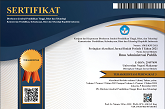Public Financial Information Disclosure by the Regional Financial and Asset Management Agency (Case Study: Regional Financial and Asset Management Agency of Pekanbaru City)
(1) Public Administration Science, Universitas Lancang Kuning Pekanbaru, Indonesia
(2) Public Administration Science, Universitas Lancang Kuning Pekanbaru, Indonesia
(3) Public Administration Science, Universitas Lancang Kuning Pekanbaru, Indonesia
(*) Corresponding Author
DOI: https://doi.org/10.26858/jiap.v12i2.43745
Abstract
This study aims to identify and analyze Public Financial Information Disclosure by the Pekanbaru City Financial and Asset Management Agency whose information is incomplete on the official website. The research method used is qualitative with a phenomenological approach and the instruments used are observation, interviews, website tracking, and documentation. The indicators in this study are a combination of several theories, that is theory of democracy, good governance, and information disclosure, which finally obtained research indicators, that is accountability, transparency, communication, resources, leadership, and accessibility. The results of this study, that the disclosure of public financial information conducted by the BPKAD of Pekanbaru City still not implemented properly and also still not informative, presentation of financial data with online media is still used as a side job by employees, which eventually upload documents to be late or past the fiscal year. The problem is the number of employees who are minimal and less competent in their field also affects the implementation of public financial information disclosure by the BPKAD of Pekanbaru City.
Keywords
Full Text:
PDFReferences
(Erna) Ruijer, H. J. M. (2017). Proactive Transparency in the United States and the Netherlands: The Role of Government Communication Officials. American Review of Public Administration, 47(3), 354–375. https://doi.org/10.1177/0275074016628176
Dergiades, T., Milas, C., & Panagiotidis, T. (2020). Effectiveness of Government Policies in Response to the COVID-19 Outbreak. SSRN Electronic Journal, January. https://doi.org/10.2139/ssrn.3602004
Fishenden, J., & Thompson, M. (2013). Digital government, open architecture, and innovation: Why public sector it will never be the same again. Journal of Public Administration Research and Theory, 23(4), 977–1004. https://doi.org/10.1093/jopart/mus022
Herbers, M. S., Antelo, A., Ettling, D., & Buck, M. A. (2011). Improving Teaching Through A Community of Practice. Journal of Transformative Education, 9(2), 89–108. https://doi.org/10.1177/1541344611430688
Jeannot, G. (2018). From e-government to the smart city: old and new issues. Colloque European Group of Public Administration …. https://core.ac.uk/download/pdf/228095220.pdf
Kim, C., & Kim, K. A. (2021). The institutional change from E-Government toward Smarter City; comparative analysis between royal borough of Greenwich, UK, and Seongdong-gu, South Korea. Journal of Open Innovation: Technology, Market, and Complexity, 7(1), 1–33. https://doi.org/10.3390/joitmc7010042
Liu, G. (2017). Government Decentralization and the Size of the Nonprofit Sector: Revisiting the Government Failure Theory. American Review of Public Administration, 47(6), 619–633. https://doi.org/10.1177/0275074016631643
Mechant, P., & Walravens, N. (2018). E-government and smart cities: Theoretical reflections and case studies. Media and Communication, 6(4Theoretical Reflections and Case Studies), 119–122. https://doi.org/10.17645/mac.v6i4.1848
Mohammed, F. (2016). Cloud computing adoption model for e-government implementation. June. https://doi.org/10.1177/0266666916656033
Nasrullah. (2018). Implementasi Electronic Government Dalam Mewujudkan Good Governance dan Smart City (Studi Kasus: Pemerintah Kota Makassar). JUSITI: Jurnal Sistem Informasi Dan Teknologi Informasi, 6(2), 23–31.
Syamsul, S., & Ritonga, I. T. (2017). Pengaruh Tata Kelola Pemerintah Daerah Terhadap Transparansi Pengelolaan Keuangan Daerah: Bukti Empiris Pada Pemerintah Provinsidi Indonesia. Jurnal Akuntansi, 21(3), 448–460.
Taneo, S. Y. M., Hadiwidjojo, D., Sunaryo, & Sudjatno. (2017). the Roles of Local Government in Moderating the Correlation Between Innovation Speed and and the Competitiveness of Food Small and Medium-Sized Enterprises (Smes) in Malang, Indonesia. Russian Journal of Agricultural and Socio-Economic Sciences, 62(2), 42–54. https://doi.org/10.18551/rjoas.2017-02.06
Twizeyimana, J. D., & Andersson, A. (2019). The public value of E-Government – A literature review. Government Information Quarterly, 36(2), 167–178. https://doi.org/10.1016/j.giq.2019.01.001
Vinod Kumar, T. M. (2015). E-Governance for Smart Cities. https://doi.org/10.1007/978-981-287-287-6_1
Wang, X., Liu, C., & Hawkins, C. V. (2017). Local Government Strategies for Financing Energy Efficiency Initiatives. American Review of Public Administration, 47(6), 672–686. https://doi.org/10.1177/0275074015619483
Article Metrics
Abstract view : 138 times | PDF view : 36 timesRefbacks
- There are currently no refbacks.
Copyright (c) 2022 Fajarwaty Kusumawardhani, Anisa Febrianti Putri, Alexsander Yandra

This work is licensed under a Creative Commons Attribution 4.0 International License.
Diterbitkan oleh:
Program Studi Ilmu Administrasi Publik
Program Pascasarjana Universitas Negeri Makassar
JIAP Index By:

This work is licensed under a Creative Commons Attribution 4.0 International License.









